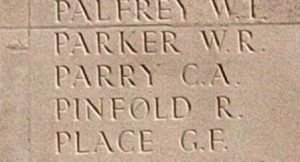Forden is a village in Montgomeryshire, situated just over three miles south of Welshpool, just off the B4388, and near to the English border. The village is on the eastern bank of the River Severn, and Offa’s Dyke runs nearby. The Parish Church is dedicated to St Michael and All Angels. On the outer edge of the Churchyard, sited on the edge of the road, sits the Parish War Memorial, which takes the form of a plain stone obelisk on a square plinth, bearing the names of the fallen of both World Wars. (I do not have a clear image of the names on the WW2 section of the memorial, so would be most grateful to hear from someone who is able to get a decent photograph of it, showing the names).
The Great War, 1914-1918
William Henry Beaman, Private, 21828, King’s Own Yorkshire Light Infantry. William was born at Forden in 1885, the son of Henry Beaman and Mary Beaman (nee Rogers). His mother was from Forden, the daughter of George and Jane Rogers. By 1888 the family had moved to Bourton, then after that they had moved to The Crossing, Stokesay. William worked as a Footman at Delamere House, Northwich prior to enlisting into the army in London soon after the outbreak of war, and was posted to France on 10 June 1915, joining the 1st Battalion, King’s Own Yorkshire Light Infantry, which was attached to 83 Brigade, 28th Division. William joined the battalion at La Clytte, in the Ypres Salient, where it had just re-entered the front line following a short rest period. Throughout the remainder of June, the battalion was kept busy supplying working parties, in the Kemmel area, until 25 June when it moved into the front line to begin a routine tour in the trenches. The Division enjoyed a relatively quiet summer in the line here until 23 September, when it was relieved, and began to move out of the Ypres Salient, and transferred to the Loos Sector, taking up the line at Vermelles by 28 September. The British had launched an assault at Loos three days previously, and the 28th Division had now entered the fight, taking over positions in Big Willie Trench, which had recently been captured from the Germans. On 4 October 1915, the 1st KOYLI mounted an assault against the Hohenzollern Redoubt, but had no artillery support, so met with heavy machine-gun and rifle fire, suffering heavy casualties. William was killed during the assault that day. The 29-year-old was originally buried with a comrade on the battlefield, but in 1928 their graves were recovered, and William was identified by his clothing, cap badge and by his service number on his boots, before he was re-interred in Arras Road Cemetery, Roclincourt, France on 3 May 1928. William is not commemorated on the Forden war memorial.
Frederick Charles Blockley, Private, 91664, Durham Light Infantry. Frederick was the son of David and Sarah Blockley, of Offa’s View, Forden. He resided at 29, Willow Street, Oswestry prior to the war, where he had moved to work as a Butcher. Frederick enlisted into the army at Oswestry on 2 March 1916, and was initially placed on the Army Reserve He was mobilised on 14 March 1917 and posted to Carmarthen, where he joined the 2/1st Battalion, Pembroke Yeomanry, being sent to Norfolk to join the battalion. On 12 April 1918 Frederick was transferred to the 7th Battalion, Welsh Regiment, and on the following day embarked for France, joining the 5th Infantry Base Depot at Étaples. Frederick was then transferred to the 1/6th Battalion, Durham Light Infantry. Before he had the chance to be posted to the battalion, Frederick was killed during an air raid on Étaples on 24 July 1918. The 19-year-old was buried in Étaples Military Cemetery, France. His brother, Percy Blockley, and their half-brother, Albert Richard Lawrence, also fell during the war.
Percy George Blockley, Private, 14909, Royal Berkshire Regiment. Percy was the son of David and Sarah Blockley, of Offa’s View, Forden. He worked as a Servant at Pentre Villa, Leighton prior to enlisting into the army in Birmingham, and was posted to the 8th Battalion, Royal Berkshire Regiment. The battalion had formed at Reading in September 1914, before joining the 26th Division on Salisbury Plain, and on 7 August 1915 embarked for France, disembarking at Le Havre the following day. The battalion then entrained for St. Omer, before marching to Arques, and over the coming days marched in stages to Bethune, where it was transferred to 1 Brigade, 1st Division on 17 August, taking over from the 1st Scots Guards, which had joined the newly formed Guards Division. The four Companies of the 8th Berkshire’s then became attached to different regular army units in the front line, for trench initiation, over the coming days. On 27 August the battalion moved into billets at Verquin, where it was inspected by Brigadier General Reddie, and four days later marched to new billets in Ames, where the battalion began a system of training schemes in preparation for the forthcoming Battle of Loos, and the last training scheme involved a simulated assault behind a gas cloud, where the battalion advanced through smoke candles. On 21 September the battalion marched out of Ames to Bois Marquet, near Allouagne, and on the following day marched to Gosnet, where the men left their packs. By 22 September the battalion had taken over support trenches at Sailly-Labourse and Noyelles-Les-Vermelles, then on the following day took over a section of front-line trenches at Sailly-Labourse, where the men waited for the battle to begin. The Battle of Loos opened at dawn on 25 September 1915, with an intensive artillery bombardment falling upon the German lines at 05.50, which was followed by the release of poison gas from thousands of previously prepared cylinders. The wind was in the wrong direction, and the gas blew back over the British lines, causing casualties among the troops even before they climbed out of the trenches to attack. At 06.30 the infantry attacked, but found the enemy wire undamaged, and significant casualties were suffered as the men tried to find a way through. Percy was killed in action during the chaotic assault that morning. The 20-year-old has no known grave and is commemorated on the Loos Memorial, France. His brother, Frederick Blockley, and their half-brother, Albert Richard Lawrence, also fell during the war.
John Lloyd Clayton, Sapper, 434701, Royal Engineers. John was the son of John and Catherine Clayton, of 7, Morgans Row, Forden. He resided at 6, Garden Lane, Bootle with his unmarried wife Elizabeth Jones, prior to the war. John enlisted into the Royal Engineers at Bootle, and was posted to the 51st Anti-Aircraft Company, RE, which was a battery guarding the Mersey docks. John married Elizabeth at Bootle on 12 December 1916, no doubt to safeguard her and their young daughter should he be sent to the front. John remained on home service during his time at war, however, and over the winter of 1917-18 fell ill. He died of pneumonia at Seaforth Military Hospital, Lancashire on 18 January 1918. The 34-year-old was buried in Bootle Cemetery, Lancashire. John is not commemorated on the Forden war memorial.
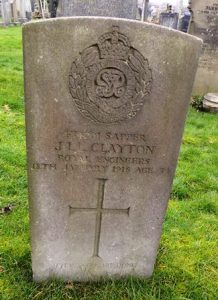
John Christopher Edwards, Private, 19790, King’s Shropshire Light Infantry. John was born at Weston Rhyn in 1883, the son of Fred and Mary Edwards. He was living at Forden by 1910, and married Fanny Whittall there that year. The couple then resided at Trelydan Lodge, where John worked as a Labourer at Trelydan Hall. He enlisted into the 7th Battalion, King’s Shropshire Light Infantry at Oswestry soon after the outbreak of war, joining the battalion at Codford, Salisbury Plain. John did not embark with the battalion when it moved to France on 28 September 1915, but remained in England until being drafted to France early in 1916, joining the 1st Battalion, King’s Shropshire Light Infantry, which was at Ypres, attached to 16 Brigade, 6th Division. The Division was holding the Canal Bank and Burgomaster Farm sector, rotating every four to six days between the front line, support trenches at La Brique, and reserve positions at Poperinghe. On 25 February the 1st KSLI moved into the front line in the Railway Wood sector, and began the same system of rotation in this notorious sector, just north of Hooge, until moving back to the Canal Bank sector in April. On 18 July the 1st KSLI moved into the front line in the Potijze Sector, following the relief of the Guards Division by the 6th Division, and began a long tour in the front line. John was killed in action here on 26 July 1917, the day the battalion was relieved from the line prior to moving south to the Somme. The 33-year-old has no known grave and is commemorated on the Ypres (Menin Gate) Memorial, Belgium.
Clement Finney, Private, 55341, Royal Welsh Fusiliers. Clement was born in 1899, the son of Morris Meyrick Finney and Sarah Finney, of Corner House, Forden. The family had moved to 5, Dysart Terrace, Newtown by 1911, where Clement worked as a shirt-maker. He enlisted into the Royal Welsh Fusiliers at Newtown, and after completing his training, was drafted to France in the winter of 1916-17, joining the 14th Battalion, Royal Welsh Fusiliers, which was attached to 113 Brigade, 38th (Welsh) Division. The Division was holding the Canal Bank sector at Boesinghe, north of Ypres, where it had moved to following its assault on Mametz Wood in July 1916. The infantry battalions of the Division then began carrying out the normal pattern of rotation in the trenches, four days in the front, four in support and four in reserve, whilst also working on trench improvement, digging new trenches, and also carrying out regular patrols and trench raids. On 31 July 1917 the Division launched its famous assault on the Pilckem Ridge, capturing Iron Cross and reaching its objective of the Steenbeek, then played a supporting role in the Battle of Langemarck. The Division was transferred to the Sailly-sur-la-Lys sector in September, and remained in the area over the winter before being moved to positions north of Albert, at Bouzincourt Ridge, at the end of March 1918, relieving the battered 2nd and 47th Divisions. It held this sector, again carrying out minor operations and trench raids, over the coming months, before taking part in the great offensive of 21 August 1918, and began its advance towards the Hindenburg Line. On 22 August the 14th RWF moved through Albert, crossing the River Ancre, and joined the 13th RWF in an assault towards Pozieres Ridge, joining 114 Brigade, to the left flank. The battalion pushed through La Boiselle, towards Contalmaison over the coming days, skirting Mametz Wood on 25 August, and capturing Bazentin-le-Grand. By 27 August the Division had reached Longueval, capturing the ruined village and reaching the Longueval to Flers Road. Clement was killed in action at Longueval on the following day, 28 August 1918, whilst the 14th RWF was holding the recently captured village. The 29-year-old has no known grave and is commemorated on the Vis-en-Artois Memorial, Haucourt, France. Clement is not commemorated on the Forden war memorial. One of his brothers, Percy, had also served with the Royal Welsh Fusiliers during the war, and died in 1922.
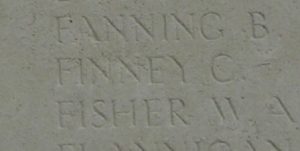
Alfred Griffiths, Guardsman, 2322, Welsh Guards. Alfred was the son of Thomas Griffiths and Mary Ann Griffiths (nee Gittins), of Kilkenydd Mill, Forden. He enlisted into the Welsh Guards at Welshpool in the summer of 1915, and was drafted to France in the spring of 1916, joining the 1st Battalion, Welsh Guards, which was attached to the 3rd Guards Brigade, Guards Division. The Division had seen its first major action during the Battle of Loos, which began on 25 September 1915, and had suffered heavy casualties at Hill 70, before also taking part in the Action of the Hohenzollern Redoubt. The Division had a brief rest in the Calais area, before moving to the Ypres Salient, and held the line at Potijze for several months. At the end of July 1916, the Division withdrew from Ypres and moved to the Somme, before holding the line north of the Ancre for a short period. By 25 August the Guards Division had moved slightly south, and had marched passed Corbie, to Mericourt-L’Abbe. By 9 September the Guards had passed Ginchy, and moved into positions at Guillemont, prior to taking part in the Battle of Flers-Courcelette the following day, the first-time tanks were ever used in action. On 12 September, after a hard fight, the Welsh Guards were relieved and moved into support positions at Bernafay Wood, to rest, before going back into the line at Waterlot Farm on 15 September, in readiness to continue the offensive. On 16 September 1916 the Welsh Guards advanced from the slopes north of Ginchy towards Lesboeufs. Alfred was killed in action during the assault, during an action that cost the Welsh Guards over 140 men. The 26-year-old has no known grave and is commemorated on the Thiepval Memorial, France.

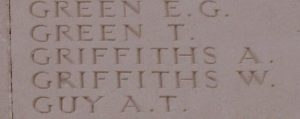
David Frank Jones, Private, 39171, King’s Own (Royal Lancaster Regiment). David was the son of William and Mary Jane Jones, of Fron Crossing, Forden. He lodges at Rose Cottage, Newbridge-on-Wye and worked as a Clerk for the Cambrian Railways at their booking office in Newbridge-on-Wye prior to enlisting into the 72nd Battalion, Training Reserve at Welshpool on 26 August 1916. David was initially placed n the Army Reserve, but was mobilised at Shrewsbury on 25 April 1917, before being posted to Prees Heath Camp for training. On 27 June David was transferred to the 76th Battalion, which was affiliated to the 12th (Reserve) Battalion, the King’s Own (Royal Lancaster Regiment), still at Prees Heath. Within days David took ill, and was hospitalised at Prees Heath, where he was diagnosed as having contracted tuberculosis. He was discharged as medically unfit on 20 November 1917, and returned home to Forden, where he died of tuberculosis on 21 December 1917. The 19-year-old was buried in St. Michael’s Churchyard, Forden on Boxing Day, 26 December. David is not commemorated by the CWGC as a casualty of war. His brother, Pryce, had been killed on the Somme the previous year.
Pryce Jones, Private, 39154, South Wales Borderers. Pryce was the son of William and Mary Jane Jones, of Fron Crossing, Forden. He worked as a canal labourer prior to enlisting into the 3/1st Battalion, Montgomeryshire Yeomanry at Welshpool, and was posted to Park Hall Camp, Oswestry for training. Pryce was drafted to France early in 1916, and was transferred to the 1st Battalion, South Wales Borderers, which was attached to 3 Brigade, 1st Division. He probably joined the battalion among a number of drafts who joined at Le Brebis on 29 February, where the battalion was resting following a prolonged period in the line at Loos. The battalion remained there until 5 March when it moved back into support trenches at Maroc, and occupied dug-outs and cellars some 600 yards behind the main fire-trenches. The Division remained in this sector, its infantry battalions carrying out the usual routines of trench rotation, until 3 June 1916, when it was relieved and moved to Calonne and began carrying out training schemes in preparation for a move south to the Somme, to take part in the great offensive which was to be launched there on 1 July. By 10 July 1916 the Division had reached Albert, where it was billeted before moving forwards, past the recently captured Mametz Wood, on 14 July, taking up positions facing Bazentin Ridge. The Division then took part in the terrible fighting for Bazentin Ridge, in conjunction with the Australian assault on Pozieres, and saw heavy casualties over the coming days during fighting on the OG Lines. By 27 July the 1st SWB had been relieved and moved to camp at Millencourt to rest and rebuild, before carrying out further training schemes, in readiness to re-join the offensive. On 15 August the battalion marched from Millencourt and began making its way back to the battle zone, reaching Bazentin Wood by 20 August, and moved into bivouacs, before the men started work on consolidating the old German trenches in the locality. The battalion was back at Albert by 28 August, enjoying several days in billets before marching back past Mametz Wood towards the front on 2 September, and three days later reached the front line in front of the feared High Wood, launching an assault against the wood on 8 September, and suffering heavy casualties. Pryce was killed in action on the following day, 9 September 1916, just before the 1st SWB was relieved again. The 19-year-old has no known grave and is commemorated on the Thiepval Memorial, France. His brother, David, died of tuberculosis contracted on active service the following year.
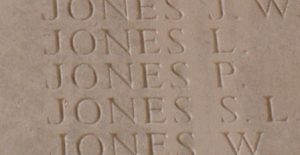
Albert Richard Lawrence, Company Sergeant Major, 44352, Manchester Regiment. Albert was born at Castle Caereinion on 21 October 1880, the illegitimate son of Thomas Leach and Sarah Lawrence, of Llanfair Caereinion. Albert was initially raised with his grandparents, but his mother married David Blockley, of Forden, in 1883, and Albert then lived with them. Albert enlisted into the Grenadier Guards as a young man, and served during the Anglo-Boer War of 1899-1902. By 1905 he had left the army, and had gained work as a railway porter, lodging at 5, Railway Avenue, Helsby. On 16 October 1905 he married Matilda Ellen Williams, of Park Terrace, Welshpool. On 20 April 1907 he joined the Cheshire Constabulary, and after completing his training was posted to Nantwich. He was then posted to Audlem for a while, before being posted to Port Sunlight in 1913 and promoted to Sergeant. Following the outbreak of war, Albert volunteered to help train new recruits, then left the Police to re-enlist into the army on 1 February 1916, joining the 17th Battalion, Cheshire Regiment, which was based at Prees Heath, and soon gained the rank of Company Sergeant Major. On 1 September 1916 Albert was posted to the 74th Battalion, Training Reserve, which was based at Prees Heath, then went to Kinmel Park, Bodelwyddan where he remained until embarking for France on 27 March 1918. Albert joined the Infantry Base Depot at Étaples for a short while, until being posted to the 12th Battalion, Manchester Regiment, joining the battalion on 1 September 1918. The battalion was attached to 52 Brigade, 17th (Northern) Division, and on 21 August 1918 had joined the great Allied offensive, attacking the Germans from positions at Mailly-Maillet, and over the coming days had cleared Martinpuich, before advancing through Flers and Gueudecourt. Albert joined the battalion near Le Transloy, and on the following day the 17th Division crossed the Bapaume to Péronne Road, before advancing towards Rocquigny, and on 7 September took part in the assault on Dessart Wood, in conjunction with the 38th (Welsh) Division. Both Divisions then faced the strongly defended town of Gouzeaucourt, and on 9 September launched a combined assault against its outer defensive lines, Heather Trench and Support; and African Trench and Support. Albert was badly wounded during the assault on 9 September 1918, being shot through the chest, and was evacuated to the 53rd Field Ambulance, where he died of his wounds later that day. The 38-year-old is buried in Rocquigny-Equancourt Road British Cemetery, Manancourt, France. He had left his bereaved wife with seven young children to raise. His half-brothers, Frederick and Percy Blockley, also fell during the war.
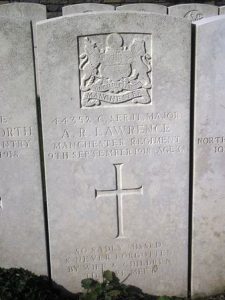
John Mason, Bombardier, 136885, Royal Field Artillery. John was the son of Thomas Mason and Jane Mason (nee Mellings), of Culmington, Shropshire. He worked as a Waggoner at Forden prior to enlisting into the Royal Field Artillery at Welshpool soon after the outbreak of war. After completing his training, John was posted to Salonika, joining one of the Trench Mortar Brigades there. The Allies had sent a combined British and French force there following the Austrian and Bulgarian invasion of Serbia in 1915, which had resulted in the Serbian army being forced to withdraw over the Greek frontier. The Bulgarians had proved to be capable adversaries during the early years of the campaign, but by the summer of 1918 their resistance was waning, and the Allies launched an assault near Doiran which smashed the Bulgarian lines. John was killed in action during the artillery barrage which preceded this assault, being killed in 17 September 1918, the day before the assault was launched. The 32-year-old is buried in Doiran Military Cemetery, Greece.
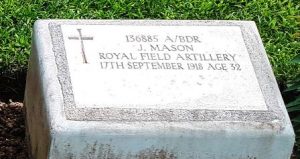
John Oliver, Private, M/288567, Army Service Corps. John was the son of John and Annie Oliver, of the Compass Inn, Fron, Forden. He worked as a Gardener prior to enlisting into the Army Service Corps at Welshpool on 28 June 1916, and was initially placed on the Army Reserve. John was mobilised at Grove Park on 12 February 1917, and joined the Motor Transport section, ASC, for training as a driver. He had been in uniform less than a month when he took ill, and died of bronchial pneumonia at Davidson Road War Hospital, Croydon on 9 March 1917. The remains of the 18-year-old were brought home for burial in Holy Trinity Churchyard, Leighton.
Thomas Edwin Owen, Corporal, 290292, Royal Welsh Fusiliers. Thomas was the son of John and Sarah Owen, of Kingswood, Forden. He enlisted into the 7th Battalion, Royal Welsh Fusiliers at Welshpool on 28 August 1914. The battalion was a Territorial unit, which mobilised for war at Newtown in August 1914, as part of North Wales Brigade, Welsh Division and moved to Conway until the end of the month, before moving to Northampton. In December the Division moved to Cambridge and then in May 1915 to Bedford, where the Division was numbered and the formation became 158 Brigade, 53rd (Welsh) Division. On 19 July 1915 the entire Division sailed from Devonport for Imbros and on 9 August 1915 landed at Suvla Bay. The infantry moved off the beaches into the bush, but due to a lack of maps and no knowledge of the terrain, many of the units became disorientated, and the situation became chaotic. After the fighting died down, the winter rolled in, and the men first had to endure torrential downpours, which flooded the trenches, before the snow hit, and many men began falling ill in the terrible conditions. The Division was eventually evacuated from Gallipoli in December 1915, moving to Egypt to join the EEF, and helped guard the Suez Canal before taking part in operations to drive the Turks out of the Sinai. The EEF then turned its attention onto driving the Turks out of Palestine, and on 26 March 1917 launched its first offensive against the coastal city of Gaza, which guarded the road to Jerusalem. Initial gains during the day were lost when the assaulting divisions lost touch with each other and communication broke down when a thick fog cloaked the battlefield. Thomas was posted as wounded and missing in action during the fighting that day, and was later found to have been captured by the Turks and taken prisoner of war. Nothing more was ever seen of him, and he was presumed as having died in captivity on or since 3 April 1917. The 23-year-old has no known grave and is commemorated on the Jerusalem Memorial, Israel. There had been considerable correspondence between the Red Crescent and the military authorities in an attempt to discover his fate, but nothing was ever positively verified.
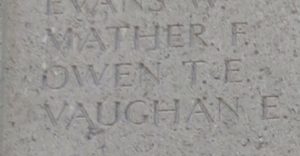
Hugh Beauclerk Mostyn Pryce, Captain, Rifle Brigade. Hugh was born at Belmont, Newport, Monmouthshire on 26 October 1881, the son of Edward Stisted Mostyn Pryce, of Gunley Hall, Chirbury, and Henrietta Mary Pryce (nee Beauclerk), the daughter of William Beauclerk, of Winchfield House, Hants. He was educated at Eton and at the Royal Military Academy at Sandhurst before being commissioned as Second Lieutenant into the Rifle Brigade, and served in South Africa during the Anglo-Boer War. By 18 January 1911 he had been promoted to Captain, and at the outbreak of war was serving with the 4th Battalion, Rifle Brigade, which was on garrison duties in India. The battalion sailed from Bombay for England in October 1914, landing at Devonport on 18 November, and moved to Magdalen Hill Camp, Winchester joining 80 Brigade, 27th Division. On 21 December 1914 Hugh landed at Le Havre with the battalion, and the battalion moved to the Blaringhem area, where they enjoyed Christmas Day before beginning work on digging trenches north of the town, at La Belle Hotesse and Steenbecque. On 5 January 1915 the battalion marched to Meteren, and on the following day marched into the Dickebusch Sector, where the 27th Division had been allocated the former French section at Voormezeele. The infantry battalions of the Division then began the usual routines of rotating in the trenches, which at the time was usually six days in the front line, six in support, and six in reserve. On 2 February the Division took over a new section of trenches in the St. Eloi sector. On 14 March 1915, the Germans attacked St Eloi after springing two mines and captured the village, trenches nearby and the Mound, a spoil heap south of the village. Soon after the attack was launched, the 4th Rifle Brigade received orders to march at once to Dickebusch, before marching to Voormezeele, and launched a counter attack against the Germans at the Mound during the early morning of 15 March 1915, to attempt to reclaim trenches lost by the Rifle Brigade and KSLI the previous day. Hugh was ordered to lead his Company in an assault to reclaim the Rifle Brigade trench, and at 04.40 he set off, leading his men from the front. Hugh was shot by a sniper and wounded during the assault on the trenches, whilst most of his men were killed. Hugh was carried back to his own lines by some of the survivors of his Company, and he was evacuated to No. 2 Casualty Clearing Station at Bailleul, where he died of his wounds on 19 March 1915. The 33-year-old was buried in Bailleul Communal Cemetery, Nord, France.
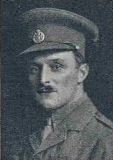
William Weaver, Private, 15229, South Wales Borderers. William was the son of Pryce and Margaret Weaver, of Finger Post Cottage, Forden. He married Annie Powell at Forden on 29 October 1902, and then found work as a coal haulier in South Wales. By 1911 the couple were lodging at 73, Church Street, Aberbargoed, with three children. William enlisted at Bargoed into the South Wales Borderers soon after the outbreak of war, and on 10 May 1915 embarked for Gallipoli, among a number of drafts sent out to reinforce the 2nd Battalion, South Wales Borderers. The battalion had landed at S Beach, Gallipoli on 25 April 1915 attached to 87 Brigade, 29th Division, and had suffered terrible casualties during the opening days of the campaign. William joined the battalion at Gully Beach on 26 May, whilst it was resting and rebuilding its strength prior to moving back into the line. On 3 May the CO, Colonel Casson, received orders for the 2nd SWB to attack the Turkish trenches, and on the following morning, the battalion moved into trenches at Geoghegan’s Bluff, before launching its assault, in conjunction with an Indian brigade. The attack failed, and the battalion was ordered to dig in, spending the coming days improving its positions in the position known as Gully Ravine. On 10 June another attack was unsuccessfully carried out by the battalion, due to the superior defensive positions held by the Turks. Fighting rumbled on over the coming days, then on 18 June the Turks opened up a heavy artillery bombardment on Gully Ravine, severely damaging the trenches, and causing many casualties. On the following day, 19 June 1915, the 2nd SWB were at work trying to repair the damage, when William was killed by further artillery fire. The 41-year-old has no known grave and is commemorated on the Helles Memorial, Gallipoli. His widow, Annie, later moved with their four children to 30, Dudderton Mill Road, Saltley, Birmingham.
Christopher Richard Williams, Private, 22357, King’s Shropshire Light Infantry. Christopher was the son of Richard and Margaret Ann Williams, of Oswestry. He married Margaret Ellen Lloyd, a Domestic Servant from Forden, at Oswestry whilst on leave early in 1916. Christopher had enlisted at Oswestry into the King’s Shropshire Light Infantry, and was drafted to France early in 1916, joining the 7th Battalion, King’s Shropshire Light Infantry, which was at Ypres attached to 8 Brigade, 3rd Division. The Division had moved to the Eperlecques sector to rest and rebuild at the beginning of February 1916, but on 14 February the Germans attacked and succeeded in capturing the Bluff by blowing up a system of mines under the British trenches. The 3rd Division was then sent back to Ypres, and took part in the fighting to reclaim the Bluff, and during ensuing actions at the St Eloi Craters. On 1 July 1916 the Allies launched a massive offensive on the Somme, and on that same day, the 3rd Division began moving out of the Ypres Salient, and began to move south to join the Somme offensive. The 7th KSLI reached Carnoy by 7 July and witnessed the attack by the 38th (Welsh) Division against Mametz Wood over the coming days, before the Welsh were relieved and by 13 July the 3rd Division was in place in trenches facing Bazentin Ridge, launching an assault against the German lines there the following day. Unfortunately, the German wire defences had been uncut by the preceding artillery barrage, and the battalion was cut to pieces in No Mans Land, and the CO, Colonel Negus, was taken prisoner by the Germans. A gallant raid by a bombing party succeeded in rescuing the CO, before the survivors consolidated, and beat off five German counter-attacks during the following days, before being relieved on 20 July and marched to Montauban. On 23 July 1916 a detachment from the battalion was sent to dig a communication trench at Bernafay Wood. Christopher was killed in action during the work that day. The 27-year-old has no known grave and is commemorated on the Thiepval Memorial, France. His widow, Margaret, re-married, and returned to Forden, where she lived at The Grange. Christopher is not commemorated on the Forden war memorial.
World War Two, 1939-1945
William Ernest Davies, Corporal, 4189316, Royal Welch Fusiliers. William was the son of Evan Davies and Kate Davies (nee Bennett), of Stonycroft, Forden. He enlisted into the Royal Welch Fusiliers after the outbreak of war, and was posted to the 1st Battalion, Royal Welch Fusiliers. The battalion had been decimated during the withdrawal to Dunkirk in May 1940, seeing particularly heavy action at the La Bassée Canal, south of Saint-Venant. As a result, it was rebuilt in England before being posted to the Far East in 1942, to take part in the campaign against the Japanese in India and Burma. The battalion saw particularly heavy fighting during the Battle of Kohima, which raged from 4 April until 22 June 1944, an action which saw the war turn against the Japanese, which had until then seemed formidable opponents. The Allies then went on the offensive in Burma, forcing the Japanese to withdraw across the Irrawaddy, and began to advance on Rangoon. William was killed in Burma during this phase of the campaign, on 13 March 1945. The 33-year-old was originally buried in Mandalay War Cemetery, but after the war the graves within the cemetery were exhumed, and re-interred in Taukkyan War Cemetery, Myanmar.
Annie Mabel Howell-Evans, Civilian. Annie was born in Broughton, Flintshire on 29 September 1871, the daughter of Canon Reverend William Howell-Evans and Elizabeth Howell-Evans. The family later lived at Edderton Hall, Welshpool. Annie lived in London prior to the war and following the declaration of war volunteered to serve as a Telephonist in the Air Raid Precaution (ARP) headquarters at 1, Sloane Court, London. At 07.47 on Monday 3 July 1944, Annie and her sister Mary were working at 1, Sloane Court, which was at the time being used as a HQ for American servicemen, when a German V-1 ‘doodlebug’ crashed into the top end of Sloan Court, killing 65 Americans and nine civilians. Annie and her sister Mary were among the dead. Annie was 72 years old when she was killed that day and she is commemorated in the UK Book of Commemoration for Civilian casualties in Westminster Abbey. Annie and her sister Mary are commemorated on an additional plaque on the Forden War Memorial.
Mary Elisabeth Howell-Evans, Civilian. Mary was born at Chester on 21 June 1870, the daughter of Canon Reverend William Howell-Evans and Elizabeth Howell-Evans. The family later lived at Edderton Hall, Welshpool. Mary lived in London prior to the war and volunteered to serve with the Women’s Voluntary Service, before being posted with her sister Annie to the Air Raid Precaution (ARP) headquarters at 1, Sloane Court, London. At 07.47 on Monday 3 July 1944, Mary and Annie were working at 1, Sloane Court, which was at the time being used as a HQ for American servicemen, when a German V-1 ‘doodlebug’ crashed into the top end of Sloan Court, killing 65 Americans and nine civilians. Annie and her sister Mary were among the dead. Mary was 74 years old when she was killed that day and she is commemorated in the UK Book of Commemoration for Civilian casualties in Westminster Abbey. Mary and her sister Annie are commemorated on an additional plaque on the Forden War Memorial.
Cyril Alfred Parry, Private, 70396, Royal Army Service Corps. Cyril was the son of Henry Parry and Ellen Elizabeth Parry (nee Evans), of Station House, Forden. He was a regular soldier, and was serving with the Royal Army Service Corps at the outbreak of war. Cyril was posted to the 51st Division Ammunition Column, which was attached to the 51st (Highland) Division, and embarked for France with the Division in January 1940 as part of the BEF, disembarking at Le Havre. On 22 April 1940 the 51st Division was detached from the rest of the BEF to come under command of the French Third Army, and was stationed in front of the Ouvrage Hackenberg fortress of the Maginot Line. When the Germans invaded France and the low countries on 10 May 1940 the BEF advanced into Belgium to meet them. The 51st Division being further south was not yet involved, and as a result did not withdraw to Dunkirk, but was instead withdrawn to form a defensive line along the Somme, where it was attached to the French Tenth Army. Following the closure of the Dunkirk evacuation on 4 June 1940, the Germans turned their attention to the south, and on the following day, 5 June, the 51st Division came under attack, being forced to withdraw towards the coast toward Le Havre for a possible evacuation by sea. The 51st Division became trapped in the coast area near Saint-Valery-en-Caux, so the surviving French and British troops withdrew into the town, setting up a defensive perimeter. No ships came to the rescue of the beleaguered troops, so the CO of the 51st Division, Major-General Fortune, surrendered his men on 12 June 1940. Cyril had been posted as missing during the defence of St. Valery, and the Red Cross tried to locate him in the numerous POW camps, to no effect. The 22-year-old was later officially recorded as having been killed on 12 June 1940. Cyril has no known grave and is commemorated on the Dunkirk Memorial, France.
